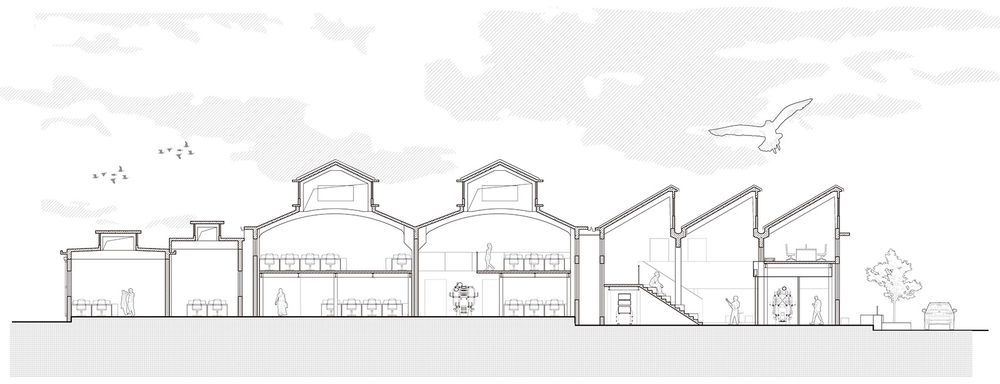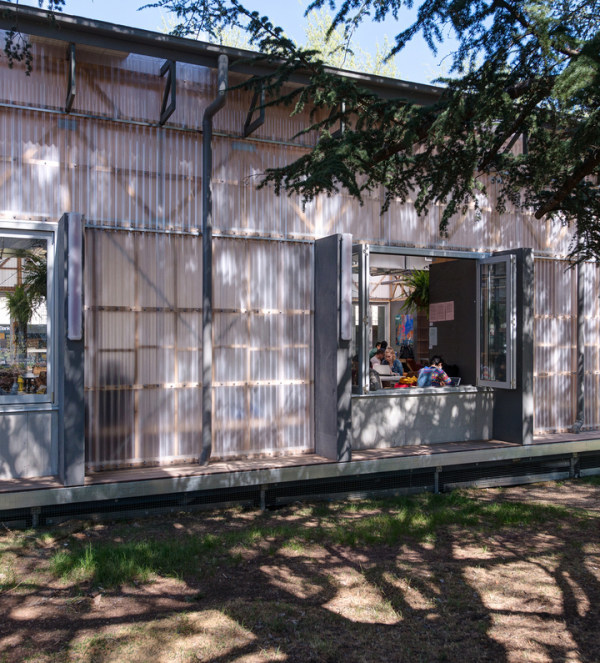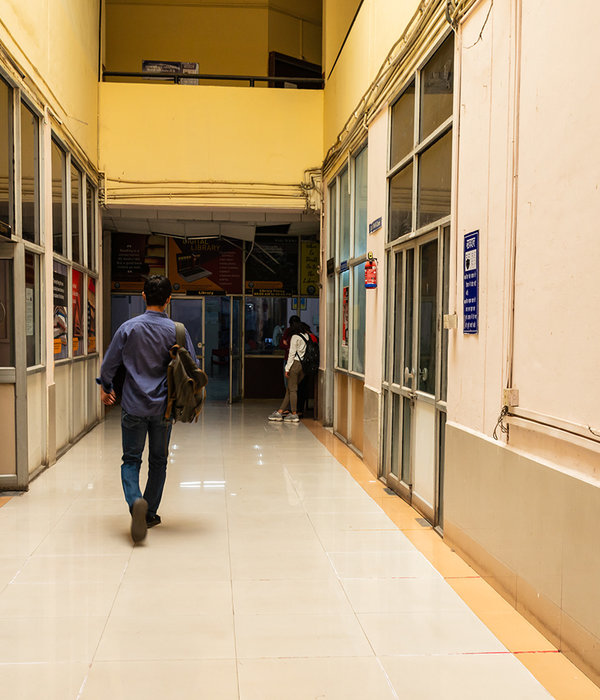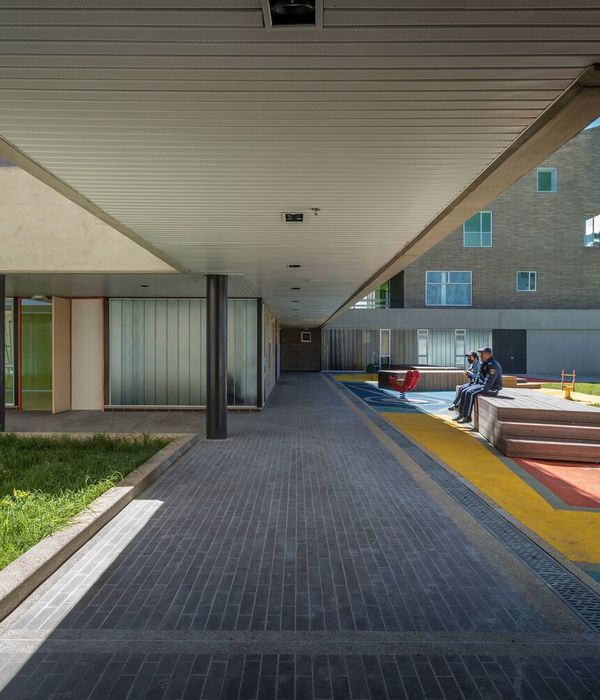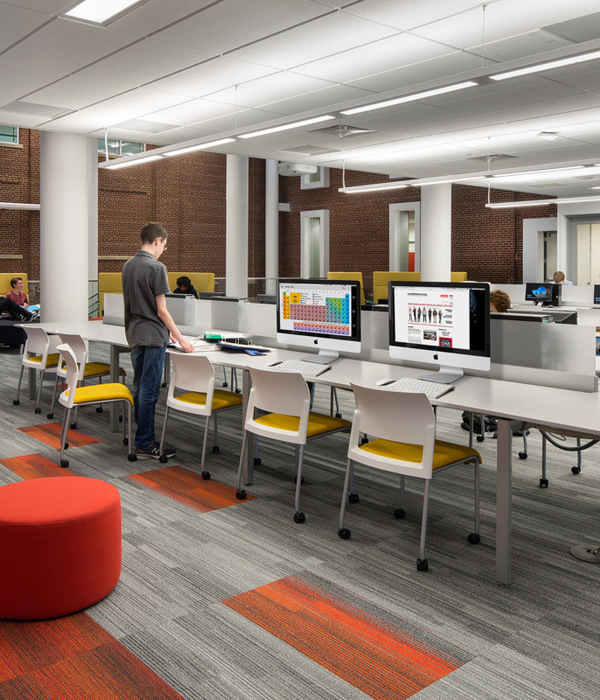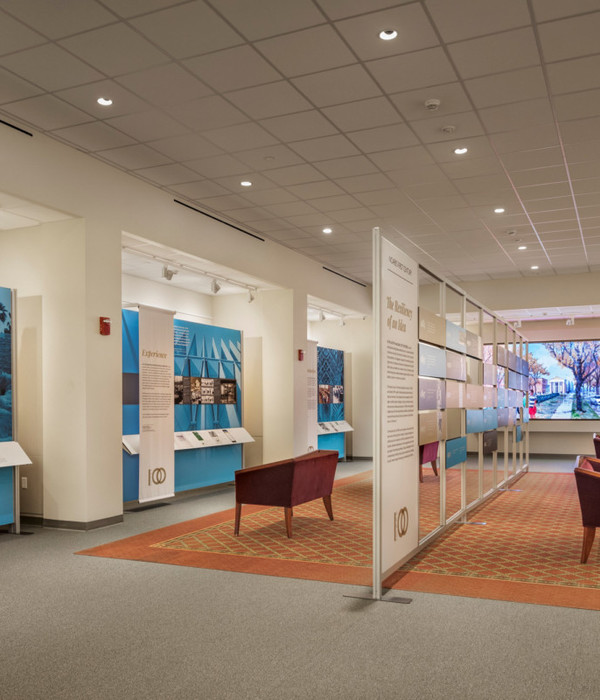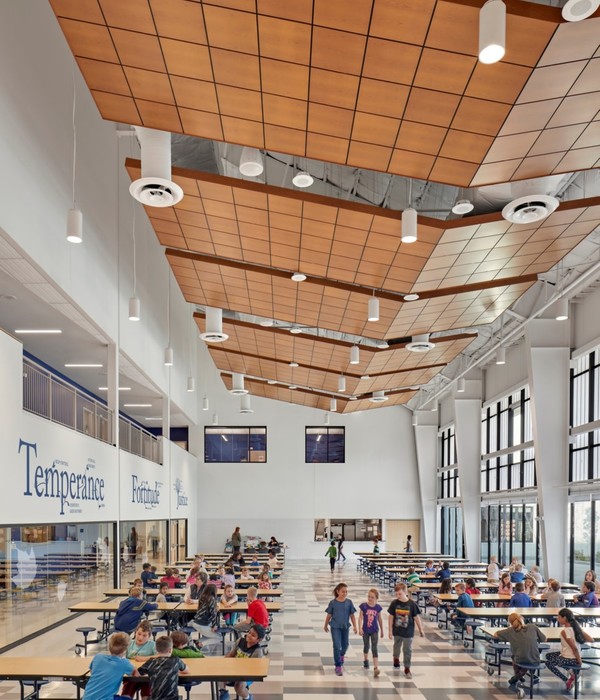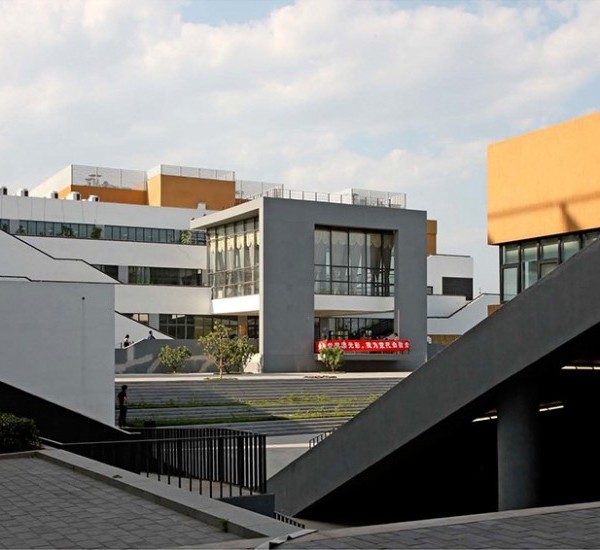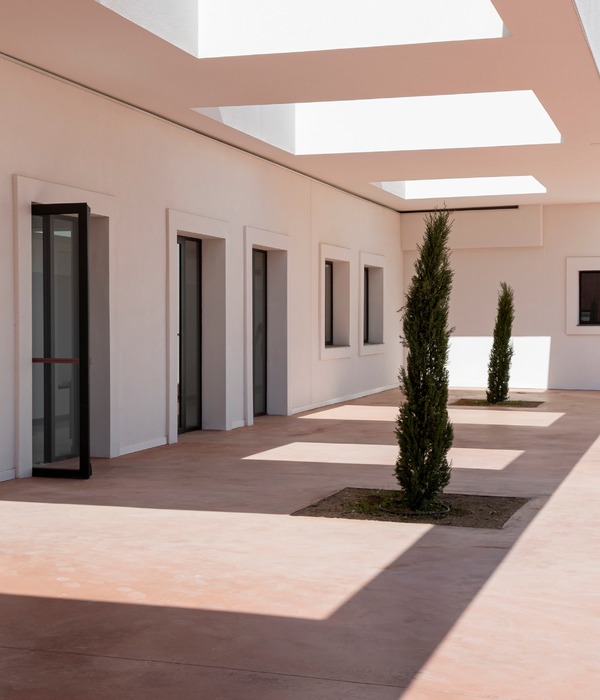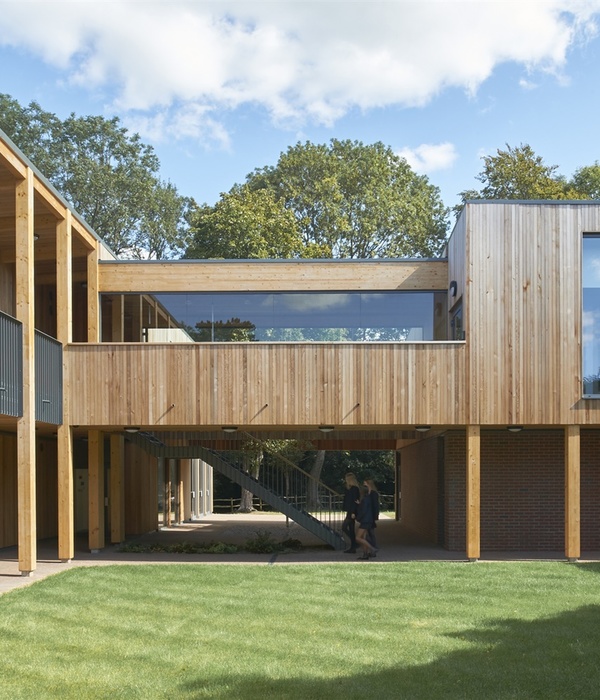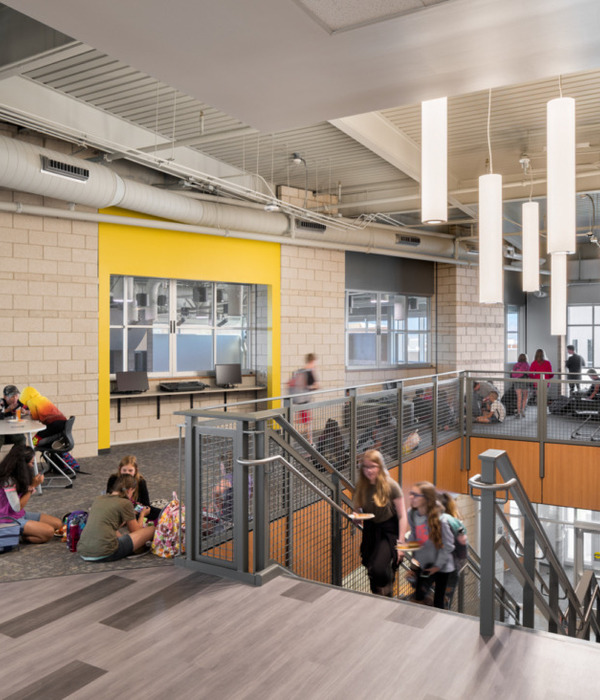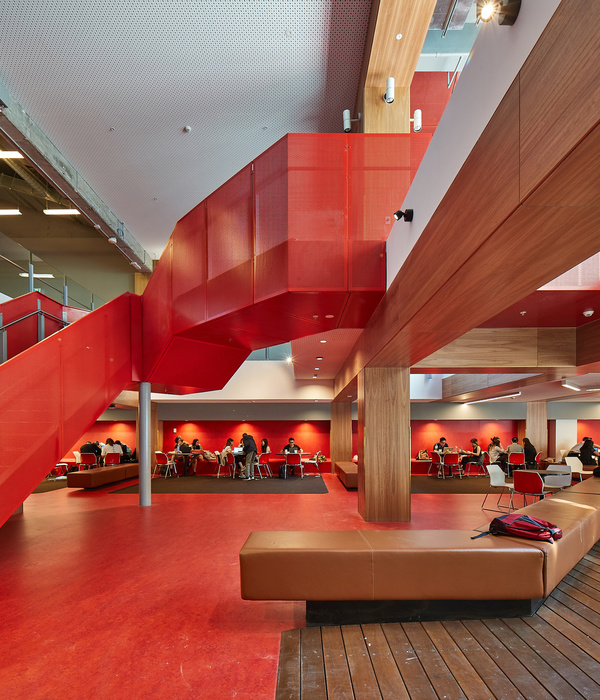盛泽坛丘缫丝厂改造,苏州 / 平介设计
项目背景 Social Background
苏州盛泽的丝绸生产与贸易源远流长,植桑、养蚕、缫丝、织绸的历史可追朔到公元前。从盛唐贡品到明清“盛绸”,盛泽生产的丝绸早已蜚声华夏。解放后,盛泽丝绸从传统手工生产逐步发展到工业化生产,创建于1969年的坛丘缫丝厂就是盛泽早期蚕丝工业化的标志之一。随着技术进步和社会发展,坛丘缫丝厂逐步退出历史舞台。近年来,在长三角一体化发展的推动下,盛泽正在经历经济飞速发展与丝绸产业升级。在当地城市更新政策的推动下,坛丘缫丝厂也面临转型升级。
Suzhou Shengze’s silk production and trade have a long history. The history of mulberry planting, sericulture, silk reeling and weaving can be traced back to BC. From the Tribute of Tang Dynasty to the “Sheng Silk” of Ming and Qing Dynasties, the silk produced by Sheng Ze has long been well-known in China. After liberation, Shengze silk gradually developed from traditional manual production to industrial production. The Tanqiu Silk Reeling Factory, founded in 1969, is one of the symbols of Shengze’s early silk industrialization. With technological progress and social development, Tanqiu Silk Reeling Factory gradually withdrew from the historical stage. In recent years, driven by the integrated development of the Yangtze River Delta, Shengze is experiencing rapid economic development and silk industry upgrading. Driven by the local urban renewal policy, the Tanqiu Silk Reeling Factory is also facing transformation.
▼建筑日景, day view © 徐英达
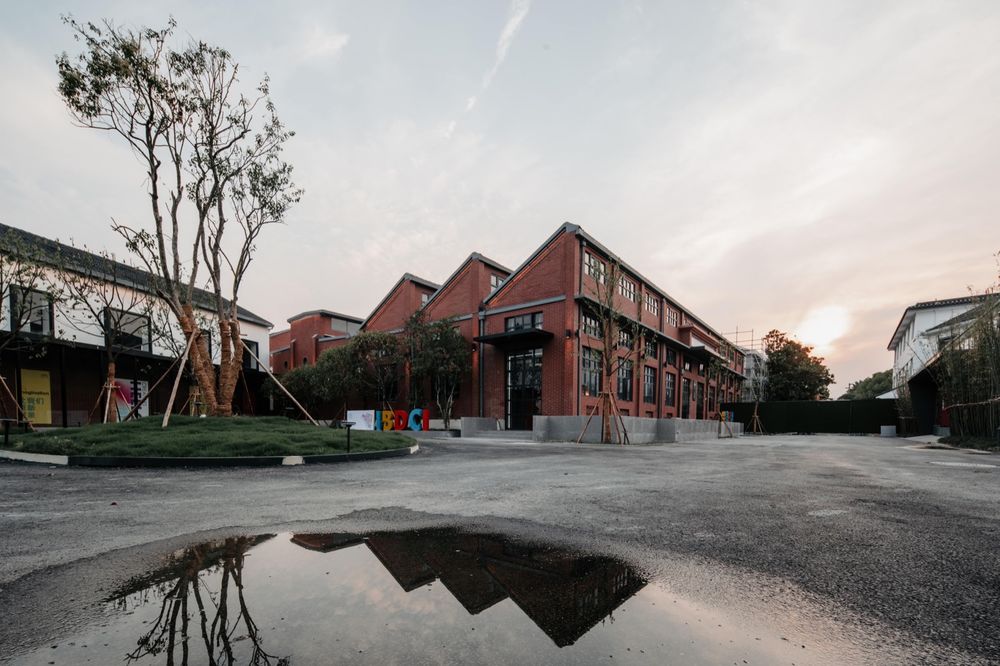
▼北立面外景,north facade © 徐英达

丝路盛泽·数字文化产业园区是由江苏远见文旅控股集团与盛泽镇政府携手合作,项目以缫丝厂旧址为核心,打造了“丝路盛泽·数字文化产业园区”。园区的设计理念围绕美学生活、产业办公和产业服务展开,形成了一个可消费、可体验、可产业化的创新型数字文化产业合作示范区。远见文旅充分利用工业遗存,遵循“城市微更修旧如旧”的原则,通过展示馆系统还原60年代末盛泽丝绸纺织工业的盛景,同时对厂房空间进行改造,打造成当代盛泽丝绸美学创新转化中心、文化演艺空间和文化旅游基地。数字文化资产(IP)的引入,结合“文+产+旅”的新方向,塑造了丝绸文旅的新地标。
▼改造之前的坛丘缫丝厂, Original situation before renovation © 平介设计
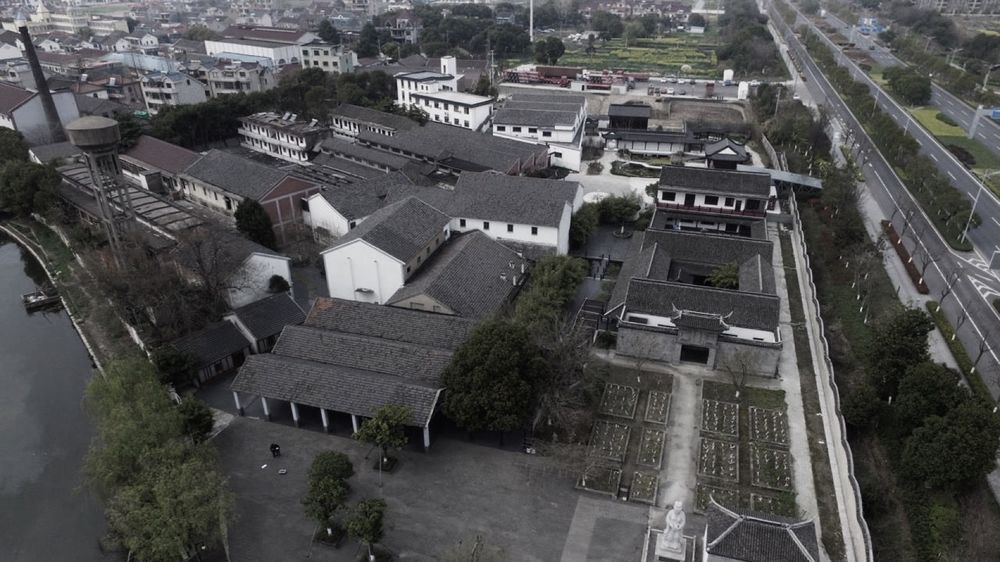
▼历史背景,historical background © 平介设计
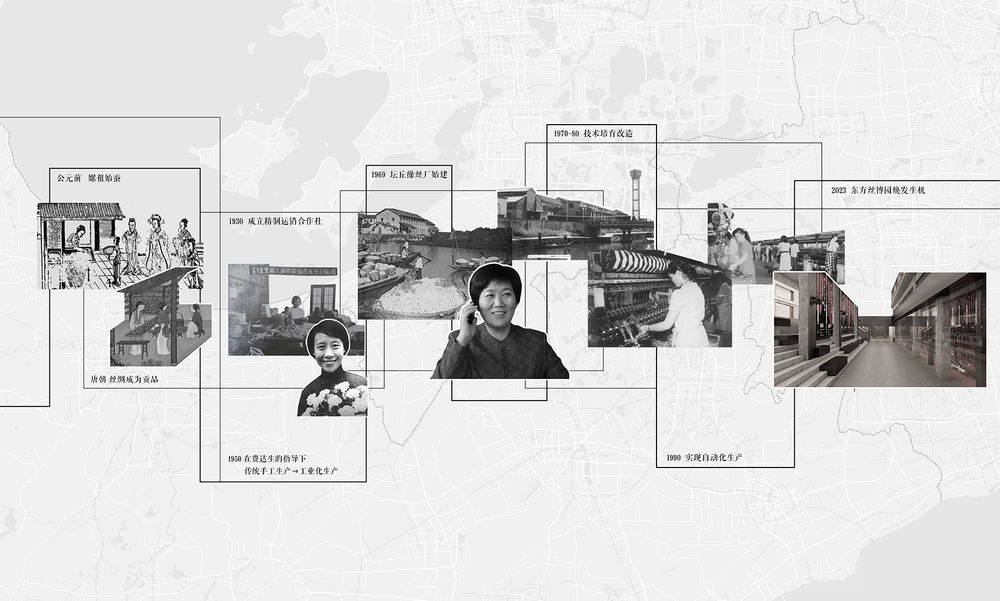
▼各空间原状,Original status of spaces © 平介设计
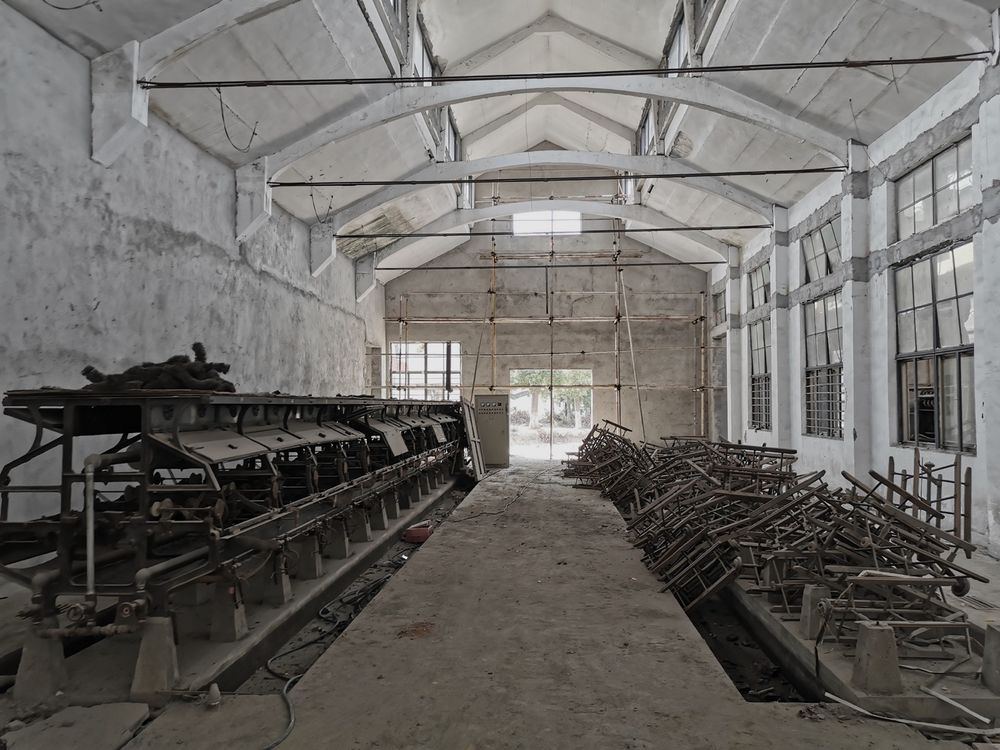
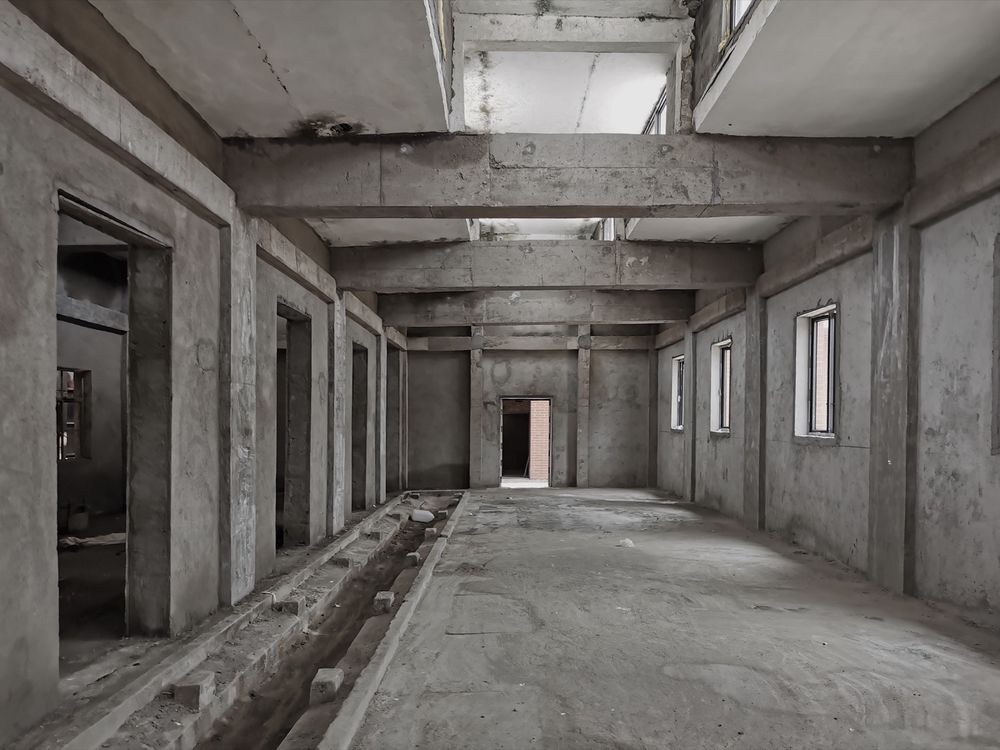

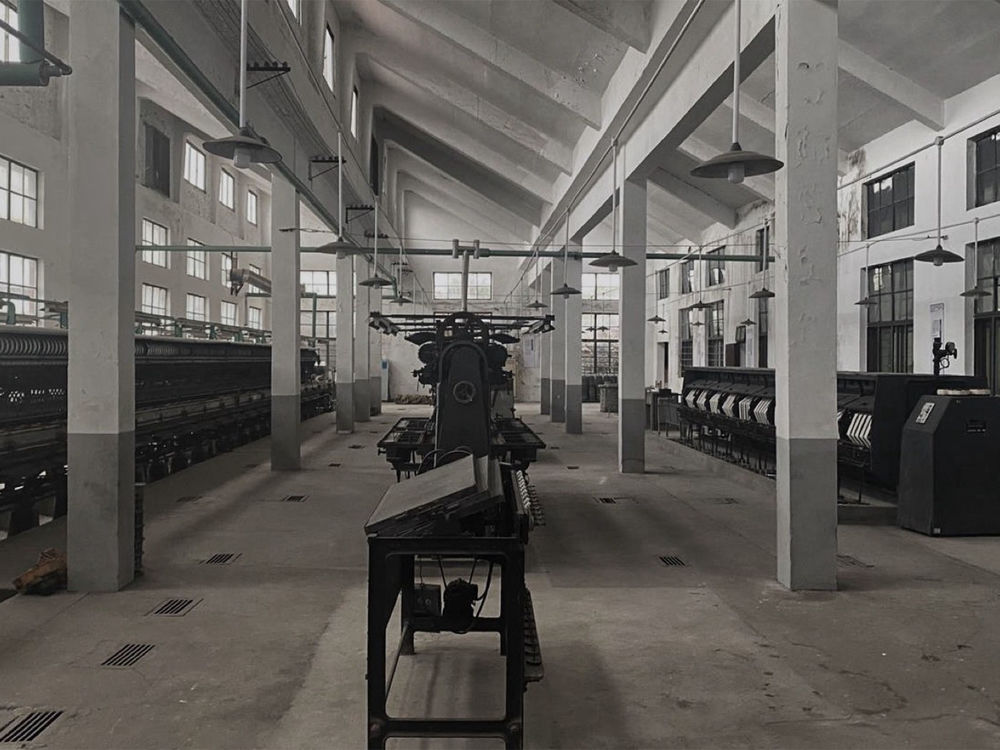
场地解读 Site interpretation
坛丘缫丝厂坐落在苏州市大运河畔的盛泽古镇,保留了相对完整的生产建筑和一系列生产机械。该厂区呈现出新中国转入现代化建设时期的典型江南纺织工业建筑风貌,是代表当地经济与工业发展的典型地标和重要工业遗产。它不仅是盛泽的“城市名片”和“集体记忆”,更是传承中国丝绸文化的重要载体。
Tanqiu Silk Reeling Factory is located in Shengze Ancient Town on the bank of the Grand Canal in Suzhou. It retains a relatively complete production building and a series of production machinery. The factory presents a typical Jiangnan textile industry architectural style during the period of New China’s transformation into modernization. It is a typical landmark and important industrial heritage representing the local economic and industrial development. It is not only Shengze’s “city card” and “collective memory”, but also an important carrier to inherit Chinese silk culture.
▼丝博园看向建筑,garden view © 徐英达

设计任务 Design tasks
本次改造的组团将作为示范区为该厂区改造后的产业园区的整体开发提供改造思路。该组团包括了位于厂区核心的选剥茧室、蒸茧车间、煮茧车间、复摇车间、缫丝车间等建筑。产权方希望保留工业遗产建筑未来作为其他用途的可能性并且满足当下文化展览以及产业办公的基本需求。
▼轴测分解图Axometric © 平介设计
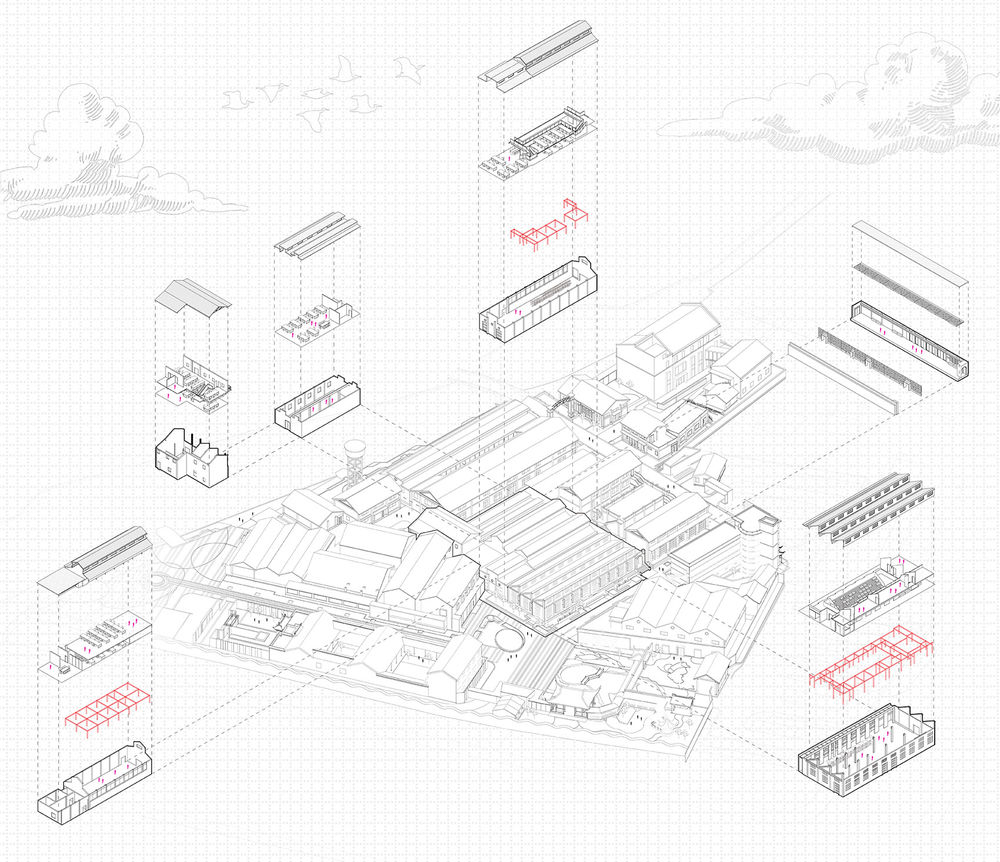
The cluster of this regeneration will serve as a demonstration area to provide regeneration ideas for the overall development of the factory. The cluster includes cocoon picking and stripping room, cocoon steaming workshop, cocoon cooking workshop, re-shaking workshop, silk reeling workshop and other buildings located in the core of the factory. The property owner wanted to preserve the possibilities of the industrial heritage building for other uses in the future and to meet the basic needs of today’s cultural exhibitions and industrial offices.
▼改造后缫丝车间大厅,main hall © 徐英达
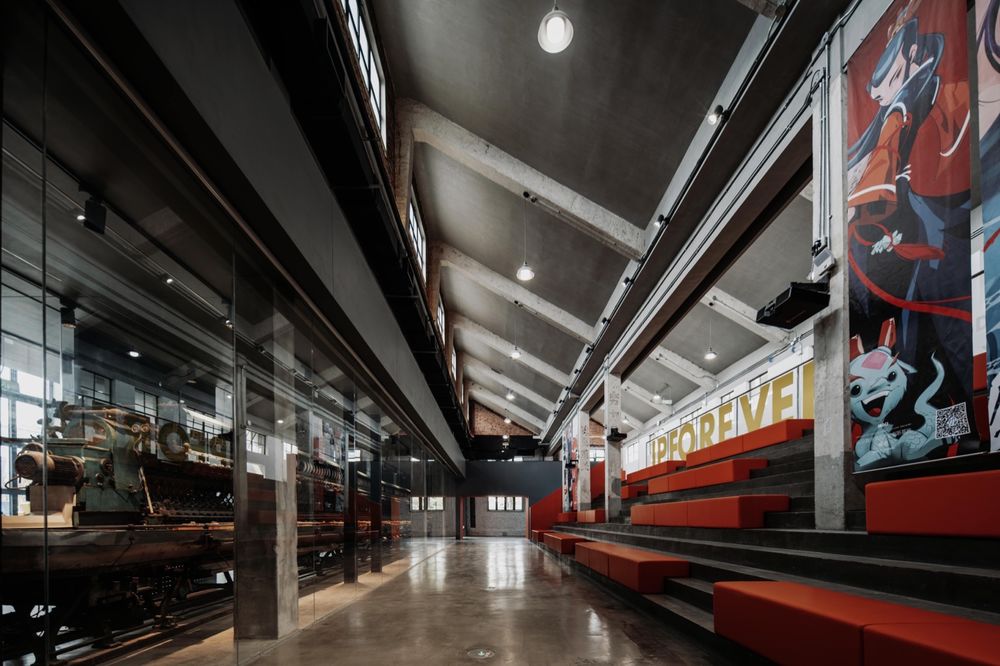
▼会议大厅模式,main hall conference mode © 徐英达
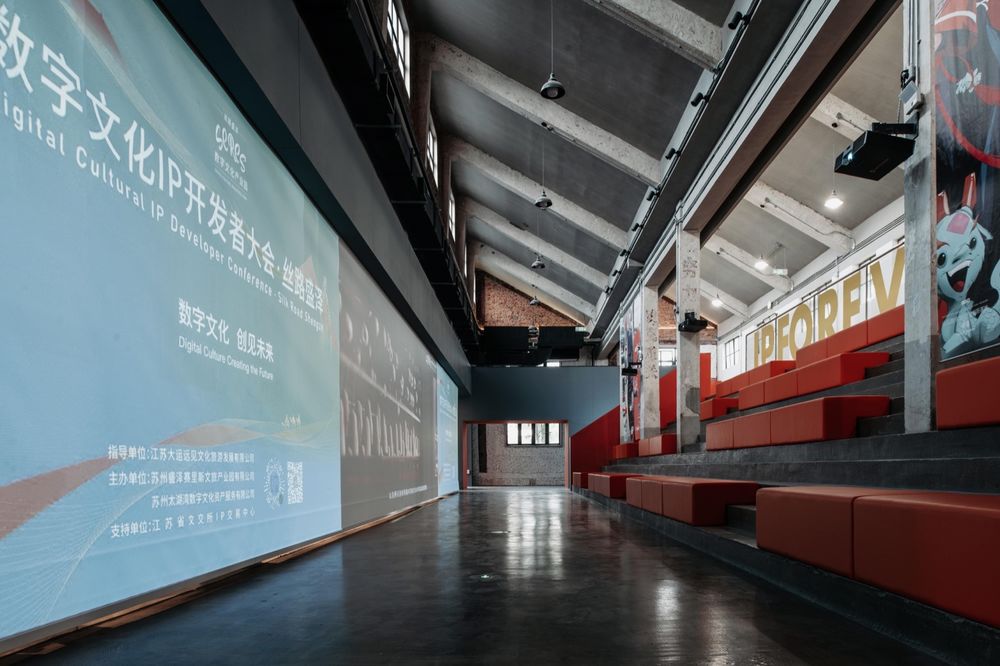
▼大厅台阶夹层,platform © 徐英达
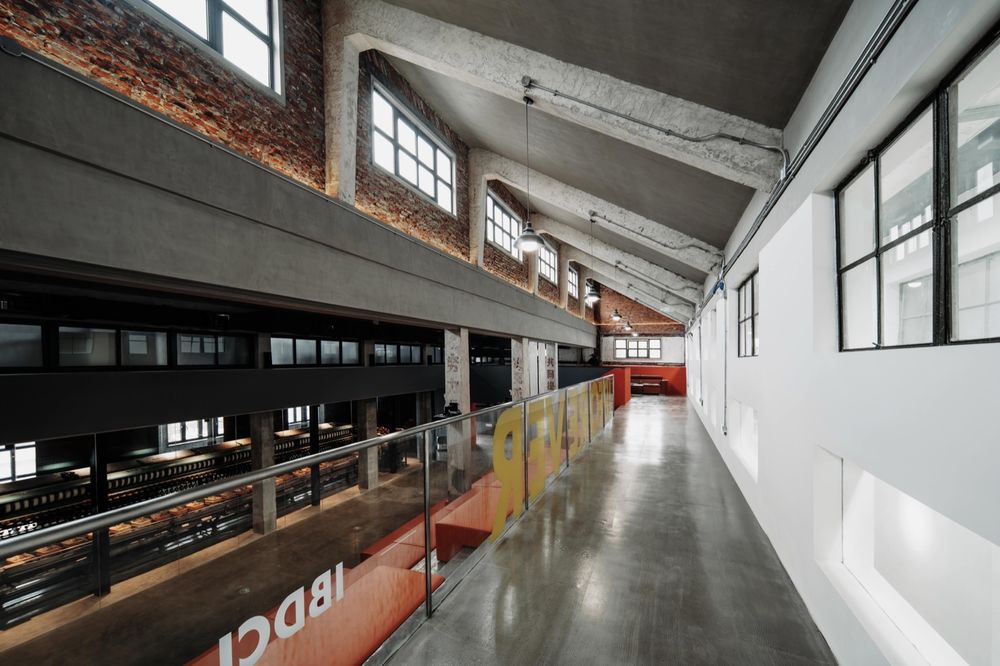
设计策略 Design strategy
原建筑组团是大尺度的联排生产车间。其丰富的屋面变化与独特的结构形式呈现出工业建筑的朴素美学与时代印记;独特的高侧窗构造塑造了明亮的内部空间;大型生产机械与残存的红色标语仿佛在诉说着它们独有的历史。面对这些不可再生的工业遗产,我们希望以“弱干预”的方式进行本次改造,尽可能减少对原建筑的拆改,保留其工业建筑特征。该建筑组团西侧的连廊作为危房已被拆除,只剩下联排生产车间。为满足内部通行及管理需求,我们在其西侧新建了公共连廊将彼此孤立的生产车间重新连接。
The original building cluster is a large-scale production workshop. Its rich roof changes and unique structural forms present the simple aesthetics and era imprints of industrial buildings. The unique construction of high side windows shapes the bright interior space. The large-scale production machinery and the remaining red slogans seem to tell their unique history. In the face of these non-renewable industrial heritage, we hope to carry out this renovation in a “weak intervention” manner, reducing the demolition of the original building as much as possible and retaining its industrial architectural characteristics. The corridor on the west side of the building cluster has been demolished as a dangerous house, leaving only the row production workshop. In order to meet the needs of internal traffic and management, we built a new public corridor on its west side to reconnect the isolated production workshops.
▼室内概览,interior overview © 徐英达
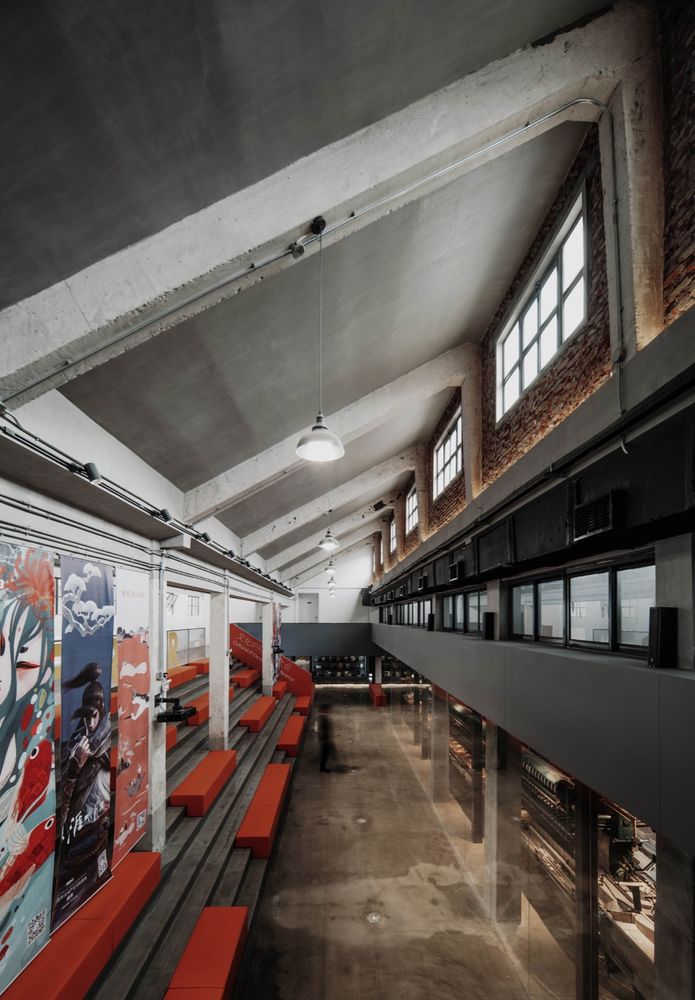
原缫丝车间被定义为展览结合自持办公的复合空间。我们将现存的大型生产机械作为“艺术装置”保留在场所当中,希望唤醒人们的时代记忆。整个空间的布局也围绕巨大的机械展开,在一层形成了三个环形动线。一层是融合了U·Talk讲堂、秀场、咖啡及辅助功能的展览空间,二层是合作伙伴中心的办公与会议空间。一二层通过巨大的模块化阶梯联系,阶梯主要作为U·Talk讲堂及秀场的观众区使用。
▼模块化阶梯示意图,Modular-stair-seats © 平介设计
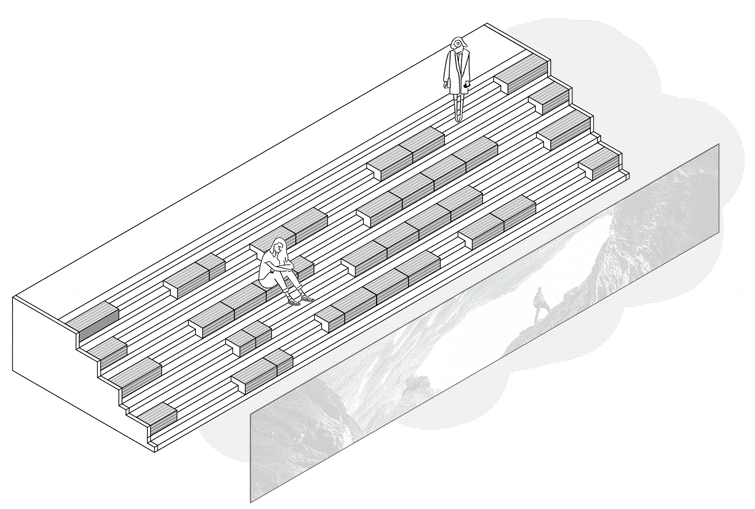
The original silk reeling workshop is defined as a complex space for exhibitions combined with self-sustaining offices. We keep the existing large-scale production machinery as an “art installation” in the place, hoping to awaken people’s memories of the times. The layout of the entire space also revolves around a huge machine, forming three circular moving lines on the first floor. The first floor is an exhibition space that integrates U·Talk lecture hall, show, coffee and auxiliary functions, and the second floor is the office and meeting space of the partner center. The first and second floors are connected by huge modular stairs, which are mainly used as the audience area of U·Talk lecture hall and show.
▼大厅入口视角,main hall entrance view © 徐英达
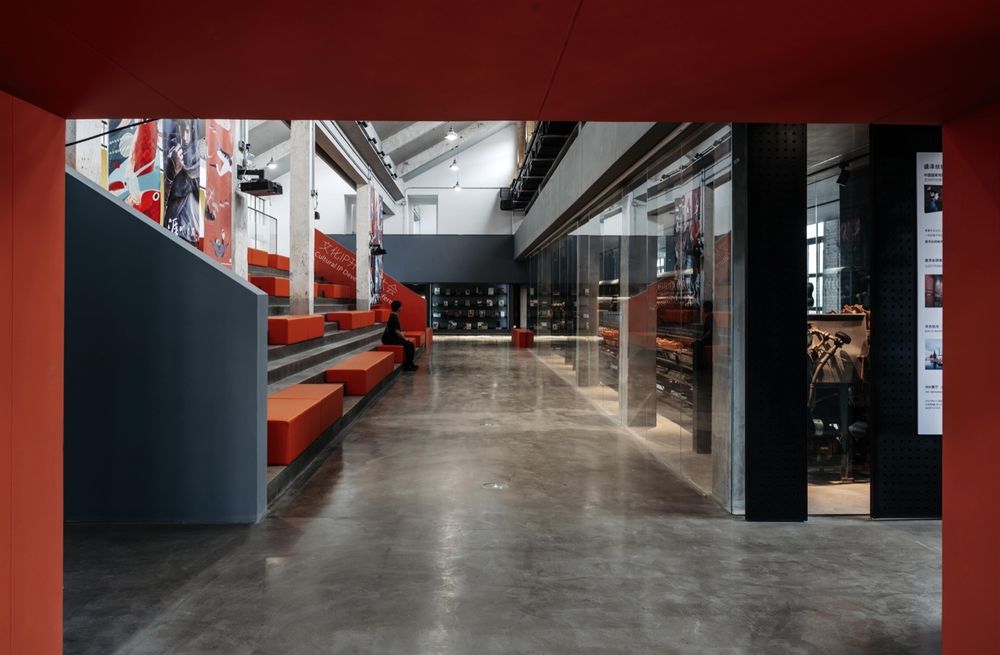
▼大厅水吧台和书吧,bookstore and bar © 徐英达
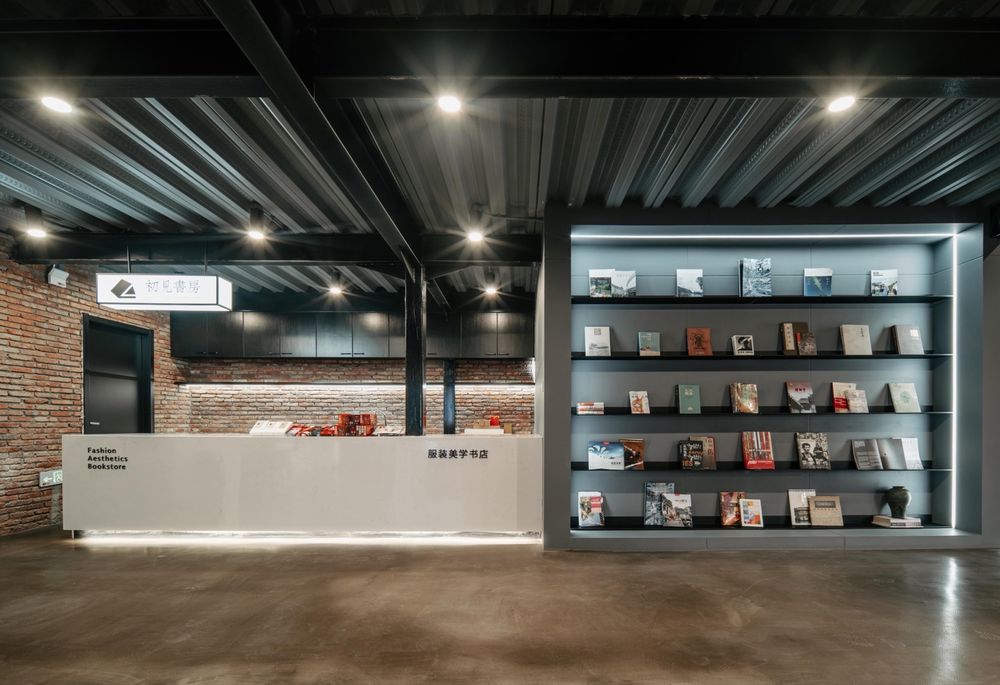
▼缫丝车间夹层空间会议室,loft meeting room © 徐英达
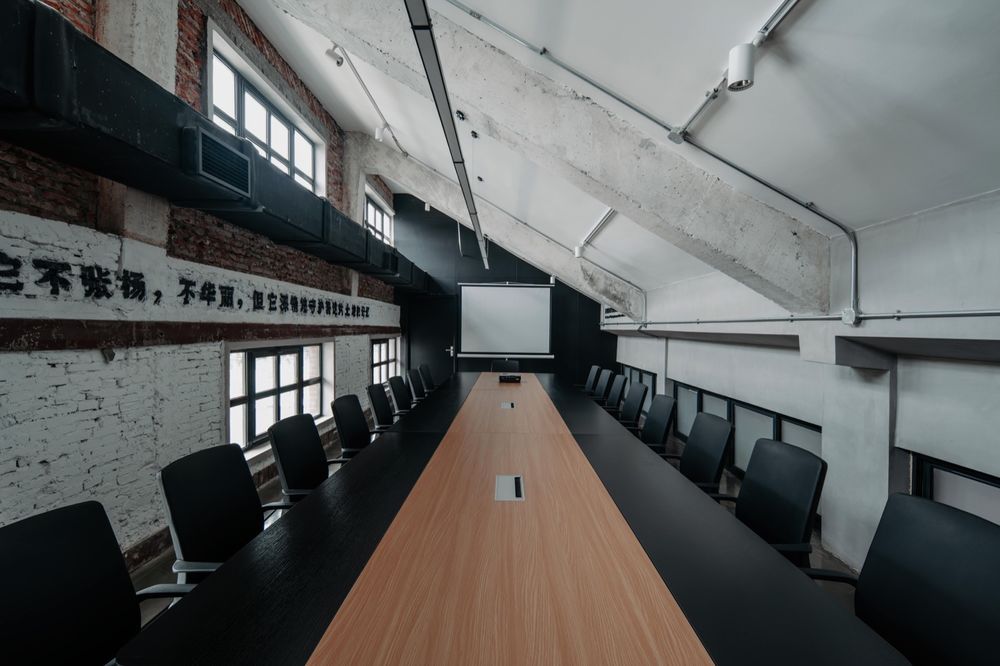
▼缫丝车间天井画廊,light well gallery © 徐英达
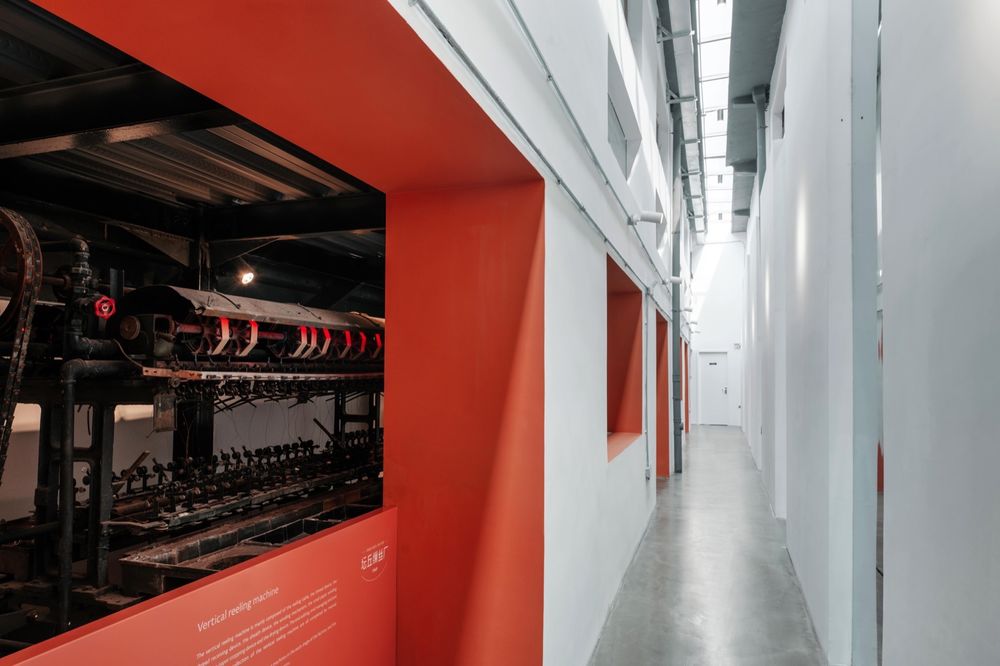
▼缫丝车间展廊,gallery © 徐英达
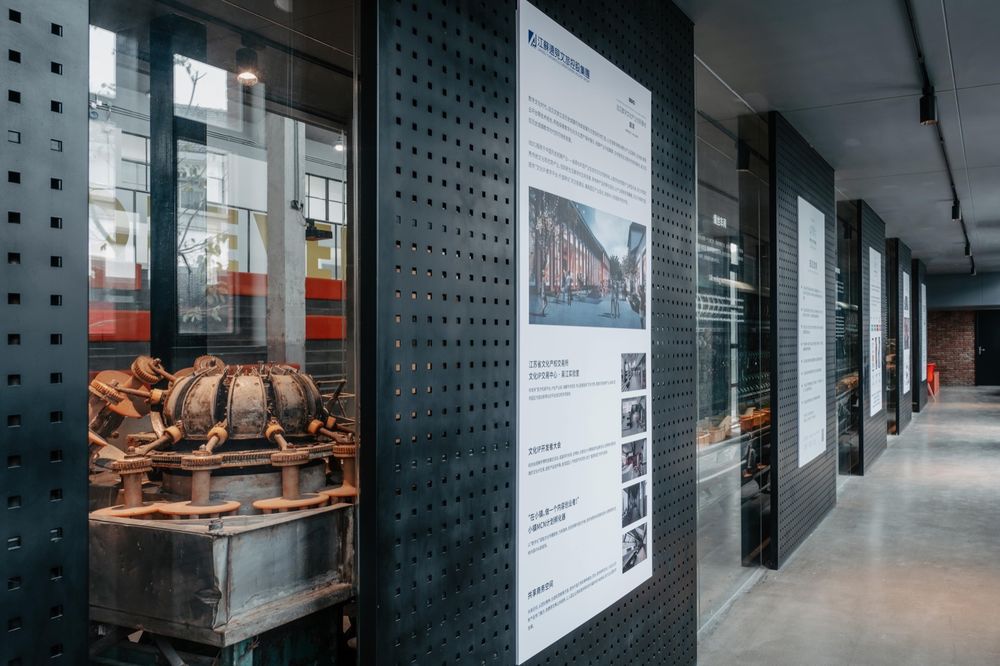
▼大厅展廊,exhibition gallery © 徐英达
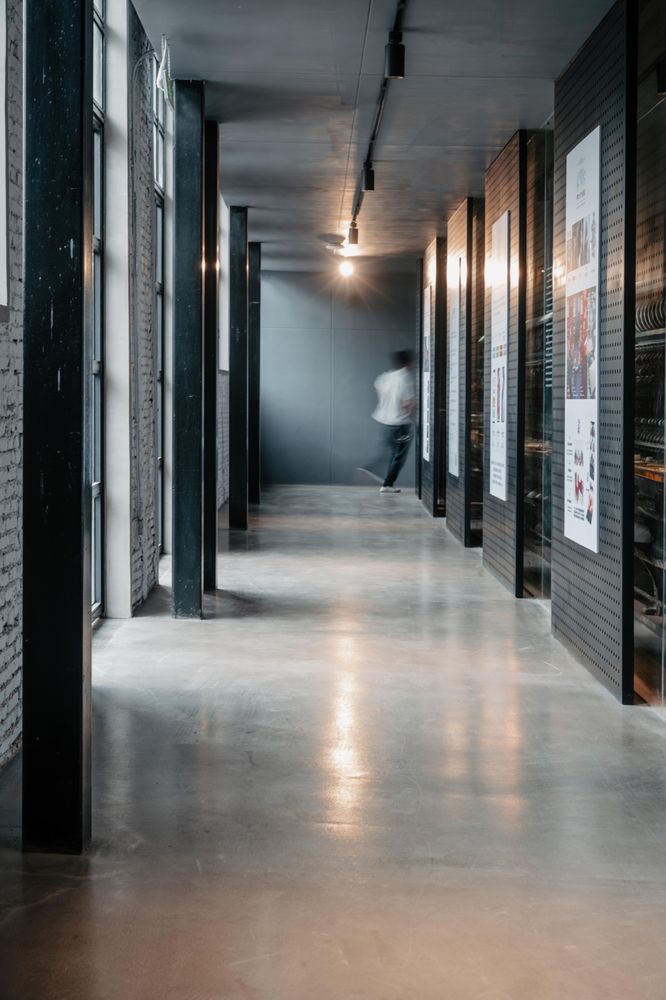
阶梯下方保留了一台煮茧机和一台复摇机,它们可以在南侧的通高展廊被观看和触摸;阶梯对面保留了一台18m长的立缫机作为U·Talk讲堂和秀场的背景,同时它也限定出走秀的环形动线。在巨大混凝土横梁的高度限制下,两个横向连廊成为整个二层空间得以环通的必要条件。位于二层的合作伙伴中心仅通过一排低矮落地窗便形成一个具有私密性的体量与开放的展览空间形成对比。
A cocoon cooker and a re-shaker machine are kept under the stairs, which can be viewed and touched in the double-height gallery on the south side. On the opposite side of the stairs, an 18m-long vertical reeling machine is kept as the background of the U·Talk lecture hall and show, and it also defines the circular moving line of the show. Under the height limitation of the huge concrete beams, two horizontal corridors become a necessary condition for the circulation of the entire second-floor space. The partner center on the second floor forms a private volume in contrast to the open exhibition space through a row of low floor-to-ceiling windows.
▼完整保留的缫丝机床,Reeling machine © 徐英达
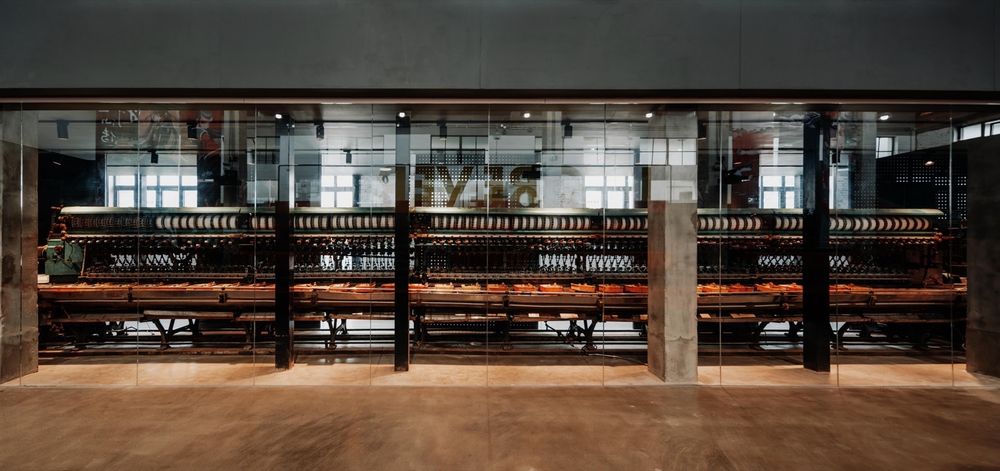
▼旧机器细部,old machinery © 徐英达
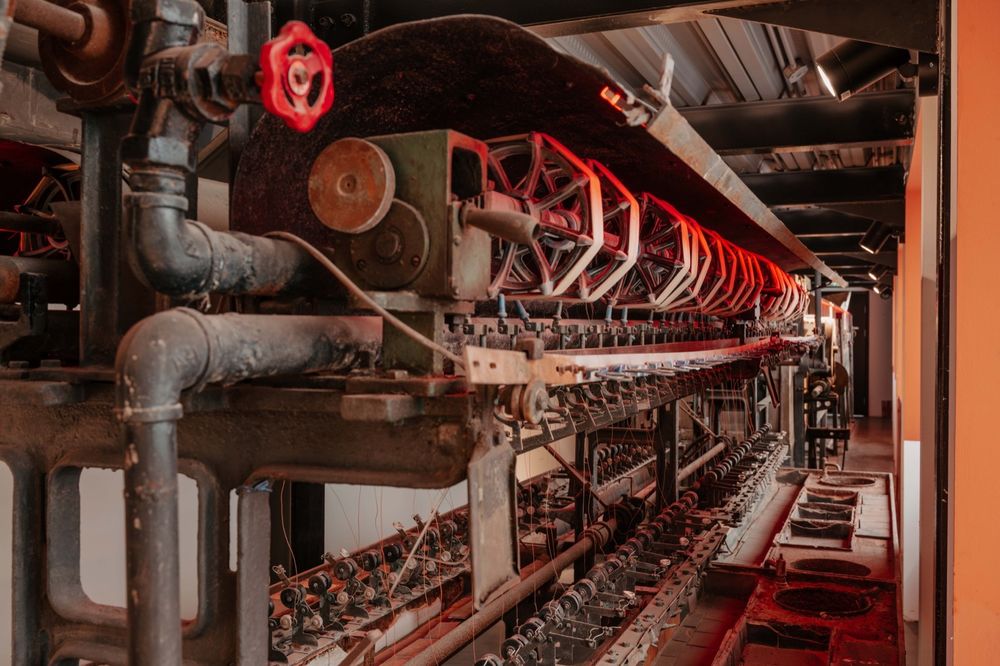

原复摇车间、煮茧车间、蒸茧车间、选茧车间被定义为对外出租的文创办公空间。其中复摇车间有大小两个开间,屋面均依靠拱梁支撑并带有高侧窗,在阳光照射下格外明亮。得益于地面下挖对原始结构钢索下净高的缓解,我们可以在其中植入夹层以满足新增的办公面积需求。大开间通过局部夹层处理形成纵向的视觉引导,同时保留部分原始生产车间的尺度,形成新与旧的对话;小开间通过整体夹层处理将高处的拱梁序列拉近到眼前,重塑空间体验。
The original re-shaking workshop, cocoon cooking workshop, cocoon steaming workshop and cocoon selection workshop are defined as cultural and creative office spaces for rent. Among them, the re-shaking workshop has two bays, one large and one small. The roof is supported by arch beams and has high side window, which are particularly bright under the sunlight. Thanks to the relief of the net height under the steel cables of the original structure by excavating the ground, we can implant a mezzanine in it to meet the needs of the newly added office area. The large bay forms a longitudinal visual guide through partial interlayer processing, while retaining the scale of part of the original production workshop, forming a dialogue between the new and the old. The small bay brings the high arch beam sequence closer to the eyes through the overall interlayer treatment, reshaping the space experience.
▼改造后的复摇车间,renovated shaking workshop © 徐英达
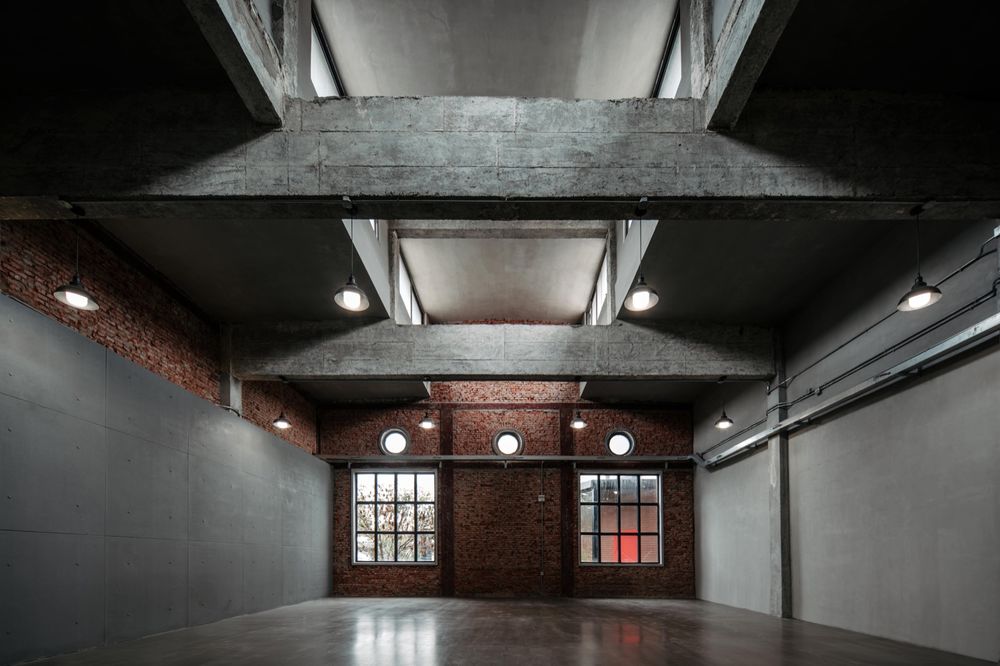
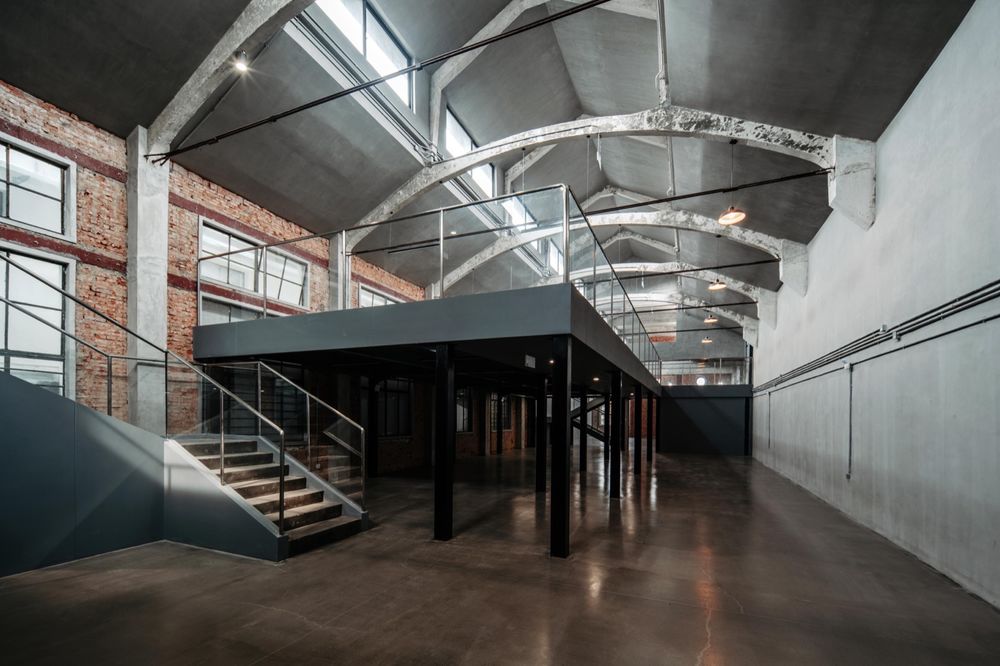
▼复摇车间夹层空间,loft space © 徐英达

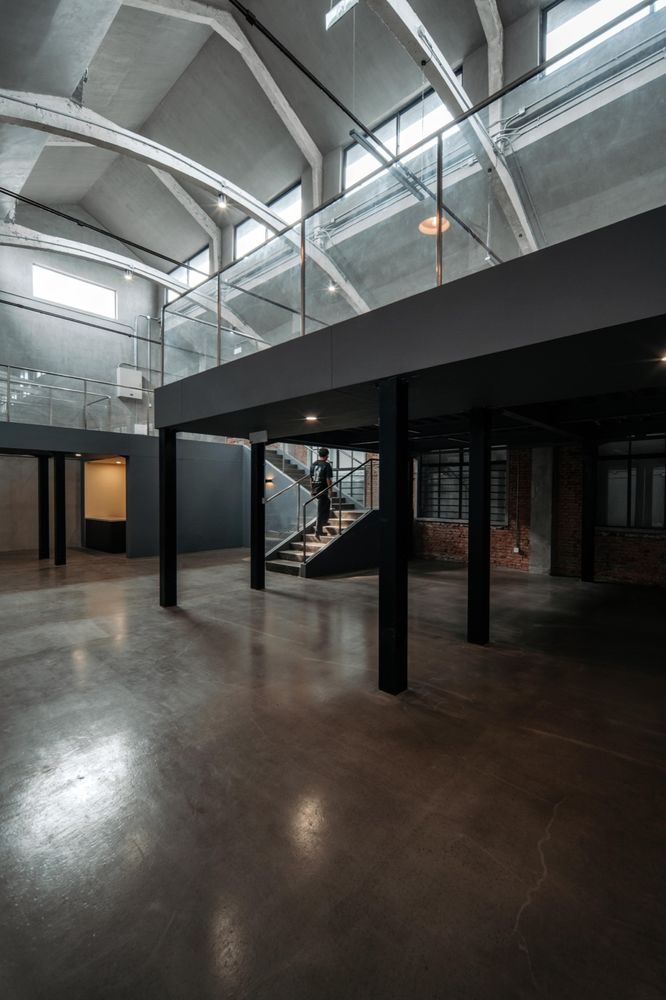
原煮茧车间在加固完成后所有的结构柱都凸出于室内墙面,显现出清晰的结构体系。除去入口植入的两个功能模块,我们仅在墙面与顶面做了材质处理以强化原始结构的关系。原蒸茧车间相对封闭,我们通过天窗将自然光引入室内,同时保留了原始的蒸茧机械。原选茧车间是一栋相对独立的两层双坡建筑,屋面由三角桁架支撑,一二层仅靠单薄的直立钢梯联系。我们通过在原建筑楼板缺口处加建旋转楼梯解决了纵向交通的问题。此外,我们也将巨大的选茧机械保留下来,希望它能够作为办公家具的一部分。
After the reinforcement of the original cocoon cooking workshop, all the structural columns protrude from the interior wall, showing a clear structural system. Except for the two functional modules implanted in the entrance, we only made material treatment on the wall and top surface to strengthen the relationship with the original structure. The original cocoon steaming workshop is relatively closed. We bring natural light into the room through skylights, while retaining the original cocoon steaming machinery. The original cocoon selection workshop was a relatively independent two-storey double-sloped building, with a roof supported by triangular trusses and a thin vertical steel ladder connecting the first and second floors. We solved the problem of longitudinal traffic by adding a spiral staircase to the gap in the floor slab of the original building. In addition, we have also preserved the huge cocoon selection machinery and hope that it will be part of the office furniture.
▼改造后的煮茧车间,renovated Cocoon boiling plant © 徐英达
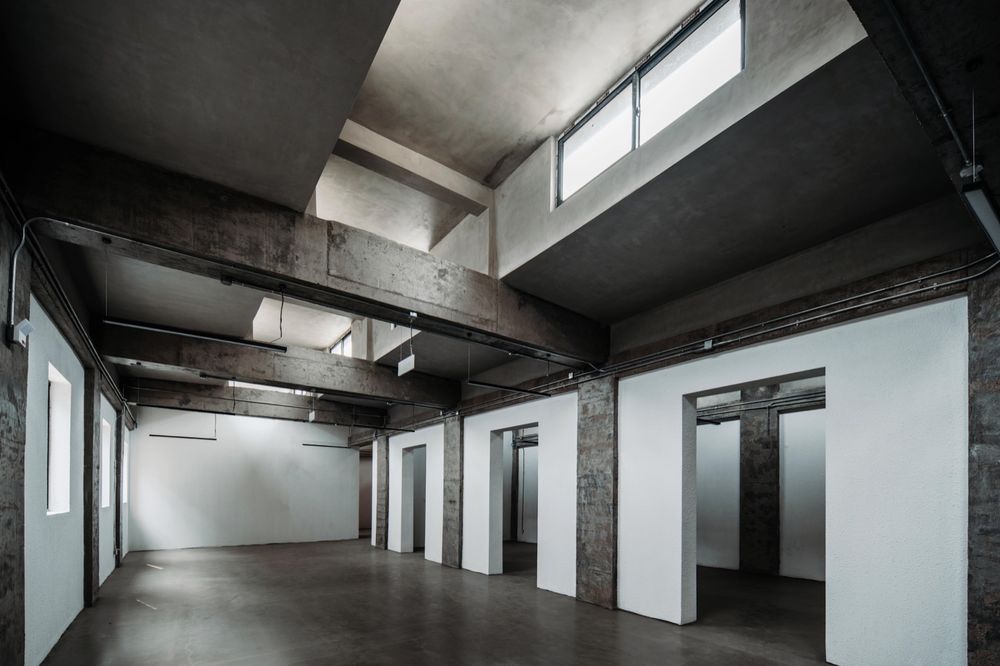
▼保留蒸馏设备的会议室,meeting room © 徐英达
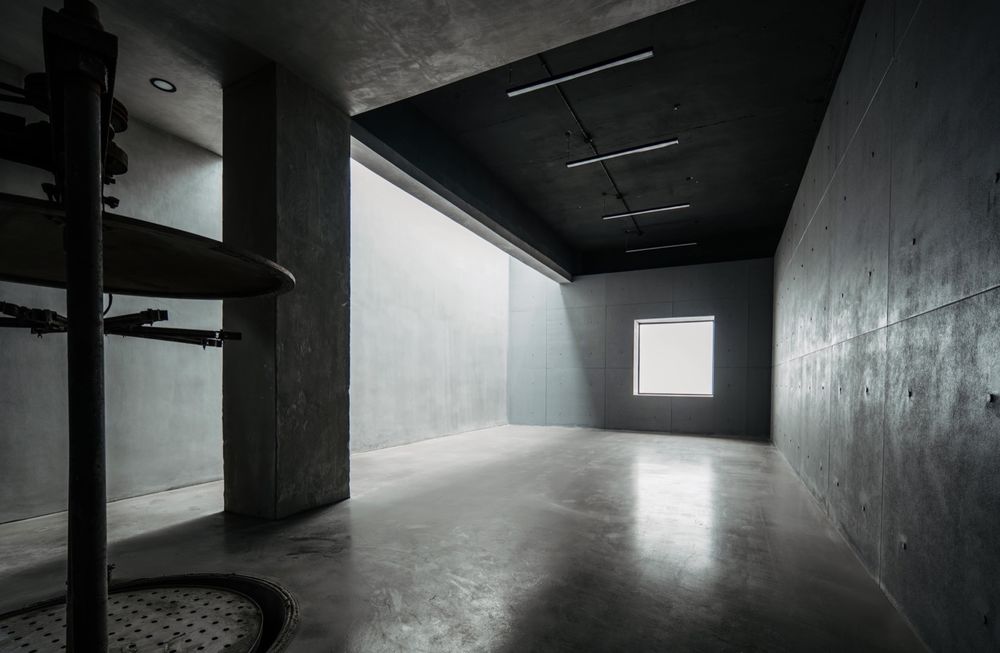
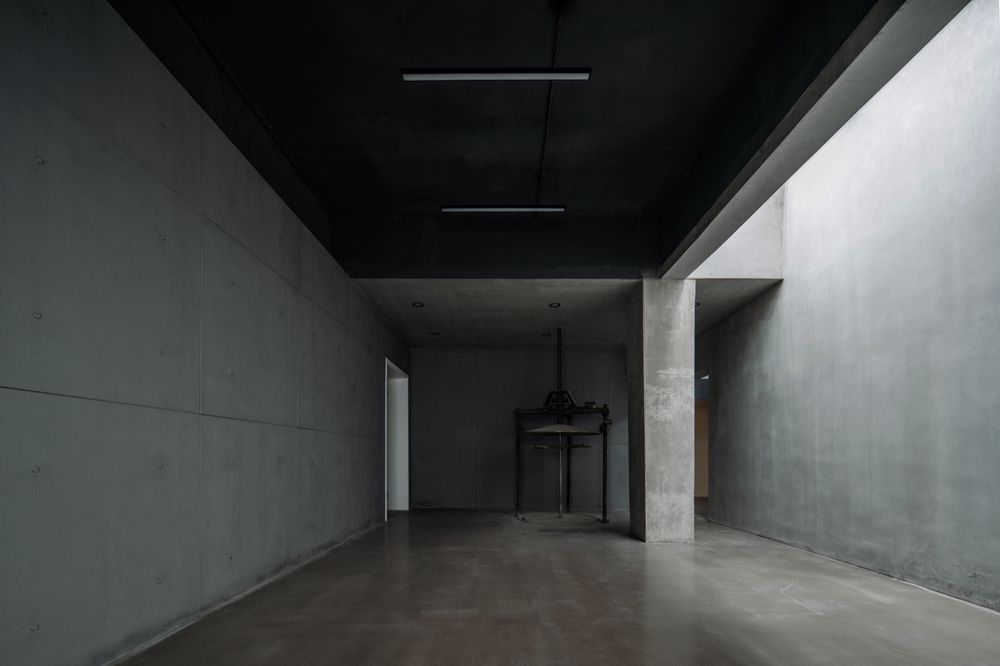
坛丘缫丝厂经历过多次翻新,我们希望剥离其在过去修补过程中增加的装饰成分,还原它的时代特征。面对过往翻新及加固带来的混乱界面关系,我们选择保留“骨骼”,重塑“块面”。将梁柱结构的面层进行剥离以突出混凝土结构的粗犷特质;将部分墙面抹灰铲除以还原其红砖建筑的本质;将水泥砂浆补丁覆盖下的加固钢板重新外露表现其经历加固的事实。
The Tanqiu Silk Reeling Factory has undergone several renovations and we wanted to strip it of the decorative components that had been added during the past repair process and restore its period character. Faced with the chaotic interface relationship caused by the past renovation and reinforcement, we chose to retain the “bone” and reshape the “block surface”. The surface layer of the beam-column structure is stripped to highlight the roughness of the concrete structure. Part of the wall plastering was removed to restore the essence of its red brick building. Re-exposing the reinforced steel plate covered by the cement mortar patch shows the fact that it has undergone reinforcement.
▼增加的旋转楼梯,added stairs © 徐英达
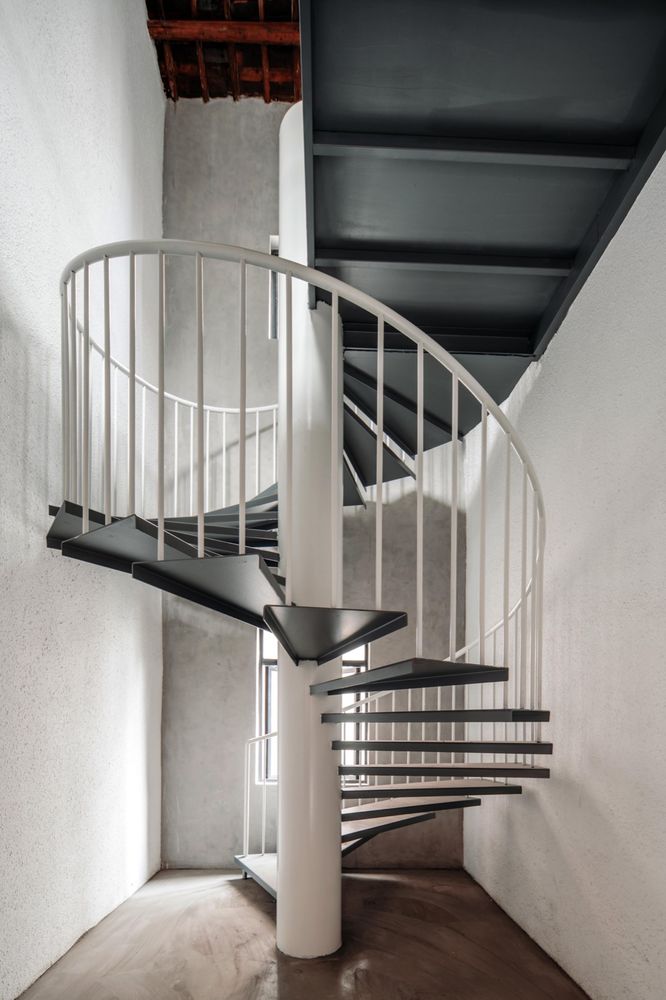
技术思考 Technical thinking
结构:原建筑结构属于特殊历史时期的复杂结构并且已经过加固处理。内部新建时我们采用了独立的钢结构体系同时避开了原结构柱及外墙的基础,以避免对原结构产生二次伤害。这样的处理也保留了该项目在未来作为其他用途再改造的可能性。
材料:在处理剥离面层后的墙体及梁柱时,我们使用了水性漆来保持其粗糙质地;在面对屋面开裂剥落问题时,我们使用了水泥漆以延续其工业空间氛围;在新建西侧连廊时我们使用了厂区内危房拆除留下来的红砖作为一种新与旧的连接;此外,我们也通过金属网、钢栏杆等材料来呼应其工业建筑属性。
设备:为保持原建筑梁柱体系及屋面的纯粹美感,所有的设备都采用贴墙或贴梁底走管的方式排布并且结合墙面及顶面的材料变化做了相应颜色的喷涂。
1. Structure: The original building structure belongs to a complex structure of a special historical period and has been reinforced. When the interior is newly built, we adopt an independent steel structure system and avoid the foundation of the original structural column and the exterior wall to avoid secondary damage to the original structure. This treatment also preserves the possibility of the project being repurposed for other uses in the future.
2. Material: When treating the walls and beams and columns after stripping the surface layer, we use water-based paint to maintain their rough texture. When faced with the problem of cracking and spalling roofing, we used cement paint to continue the atmosphere of its industrial space. When building the new west corridor, we used red bricks left over from the demolition of dilapidated houses in the factory as a connection between the old and the new. In addition, we also use materials such as metal mesh and steel railings to echo its industrial building properties.
3. Equipment: In order to maintain the pure aesthetic feeling of the original building beam and column system and roof, all equipment is arranged by way of sticking to the wall or the bottom of the beam, and the corresponding color is sprayed in combination with the material changes of the wall and the top surface.
▼旧机器细部,old machinery © 徐英达
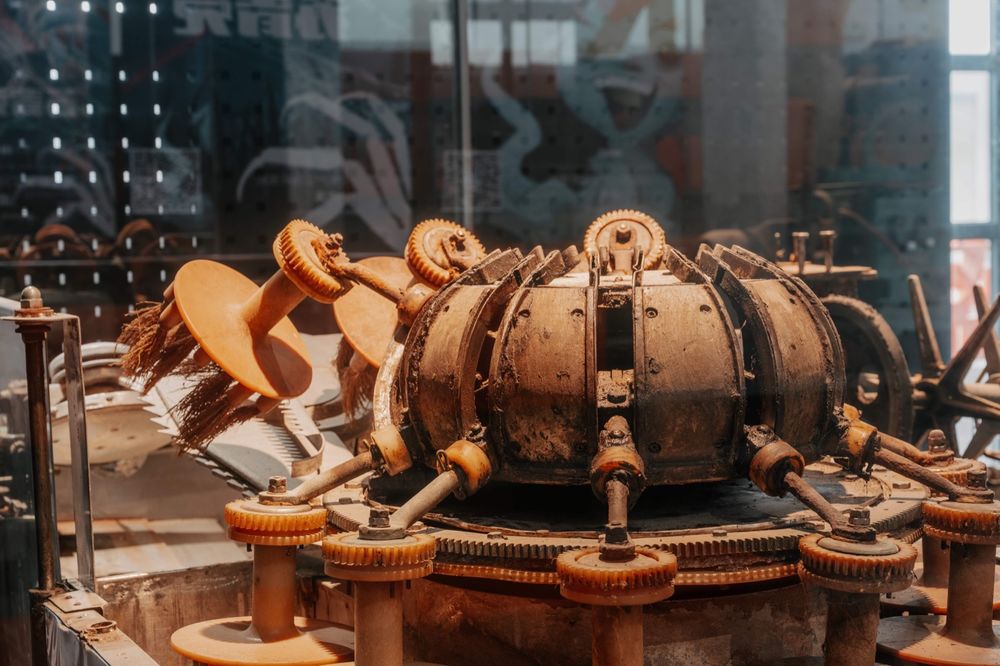
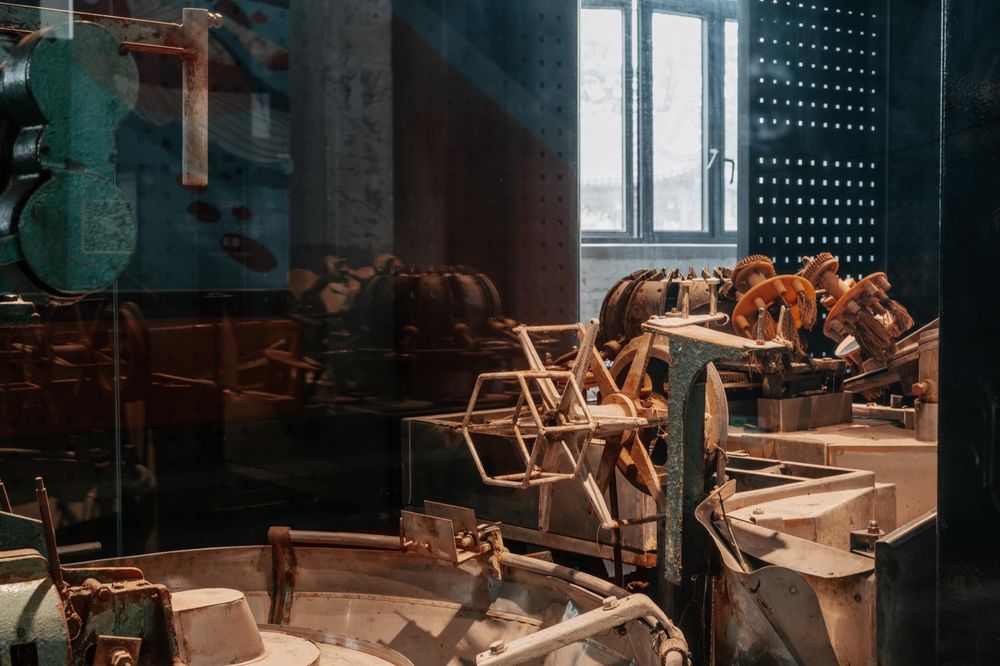
改造启示 Renovation revelations
工业遗产建筑改造本质上是在与历史对话。如何在植入新功能的同时保留历史印记,甚至保留未来再改造的可能性是无法回避的问题。植入何种功能往往受政府决策或商业策划的影响,但如何保留历史印记则更多地取决于设计策略。保留历史印记并不是简单的重建或修复老建筑,建筑会随着时间的流动而变化。本次改造采用“弱干预”的方式与历史对话,希望将一个时代特征与经济民生的缩影重新转型为创新型文创园区从而促进当地发展。
The renovation of industrial heritage architecture is essentially a dialogue with history. How to implant new functions while preserving the historical imprint and even preserving the possibility of future renovation is an unavoidable problem. What functions are implanted is often influenced by government decisions or business plans, but how to preserve historical imprints depends more on design strategy. Preserving historical imprints is not simply about rebuilding or restoring old buildings, buildings change over time. This renovation adopts the method of “weak intervention” to dialogue with history, hoping to transform the epitome of the characteristics of an era and economic and people’s livelihood into an innovative cultural and creative park to promote local development.
▼建筑夜景,night view © 徐英达

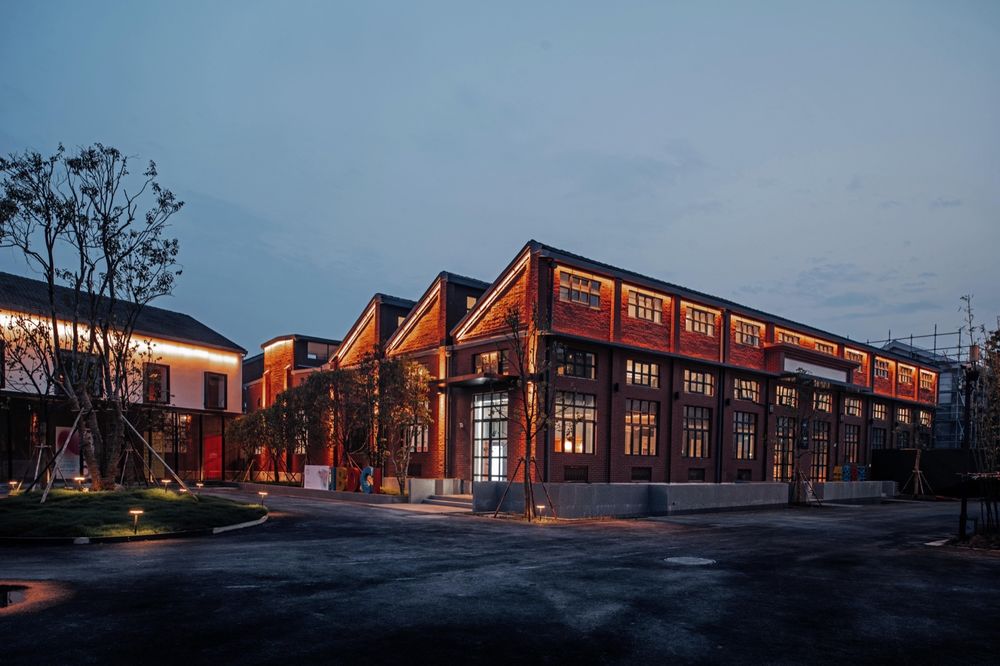
▼总平面图,Masterplan © 平介设计
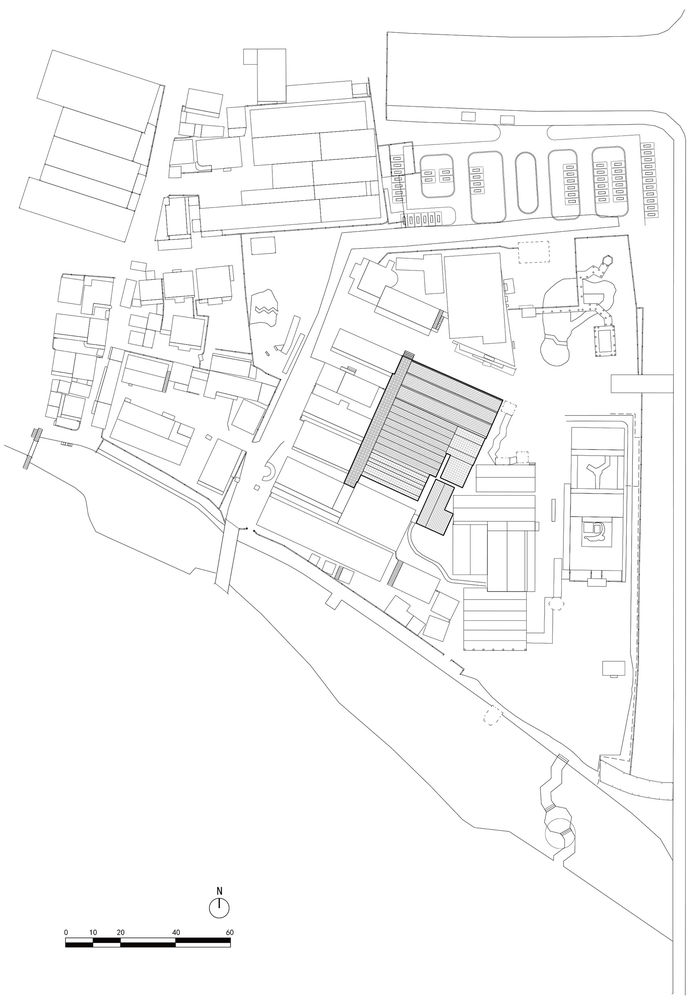
▼一层平面图,Ground floor plan © 平介设计
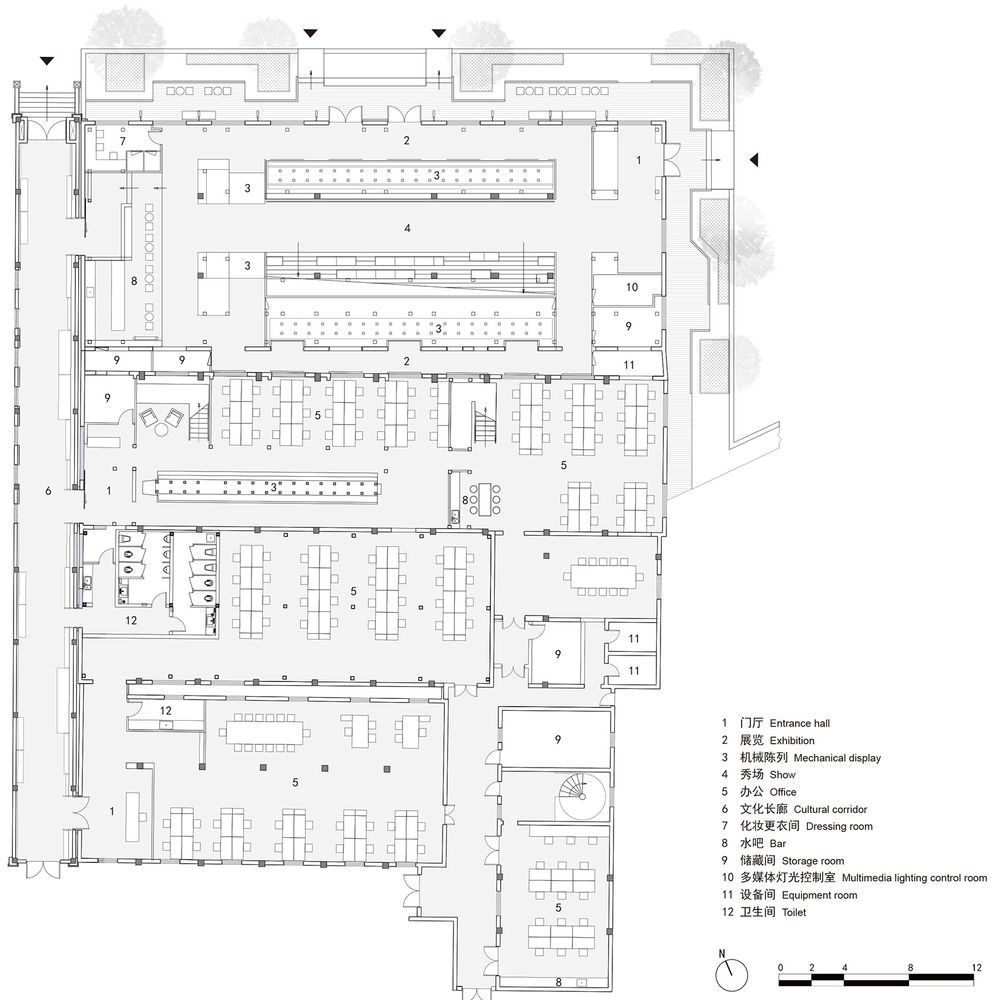
▼二层平面图,First floor plan © 平介设计
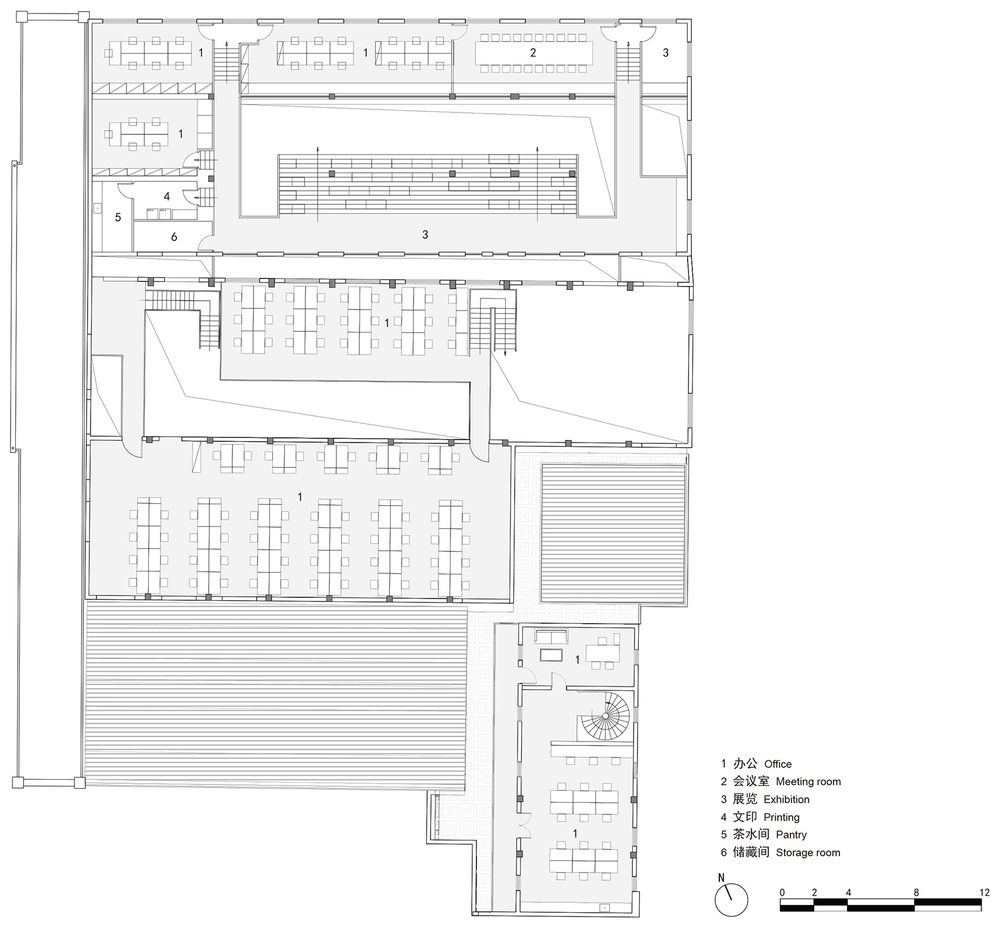
▼剖面图,section © 平介设计
